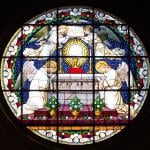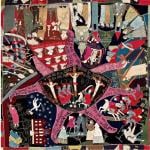I have Rome Fever.
It usually takes a bit longer to set in—I was, after all, stumbling on the cobblestones just three months ago. But the news that St. Peter’s Square is about to undergo a major renovation has me thinking: I’ve gotta see that!!
The restoration project, which was just announced in L’Osservatore Romano, is expected to take 30 months. The Bernini columns are being restored “in all of their original color and brilliance”—SAY WHAT?! Didn’t you always assume that those giant white columns along the colonnade, the great marble arms encircling St. Peter’s Square, had always been a pristine white?!
The ambitious construction project will restore and preserve
- 284 columns,
- 92 pillars,
- 140 statues,
- 6 papal coats of arms,
- 1200 meters of balustrade and crown moldings, and
- 3,400 square meters of paneled ceilings.
Also up for a facelift, the two great fountains which grace the Square:
- the Clementina and
- the Gregoriana.
And of course, the project will include the red granite Egyptian obelisk which once
overlooked the Circus of Nero, where Christians were martyred, and which was installed at the center of the Square in 1586 at the direction of Pope Sixtus V. And of course, they’ll gussy up the 18th century lamps around the obelisk.
This is a Big Project! It’ll take so long, in fact, that I don’t need to start packing yet—but another Rome trip has just made it onto my “To Do” List.
* * * * *
In the meantime, with the sights and sounds of the Eternal City stirring memories, I went through some old photos and I offer—first time ever!—a peek into some of the seldom-visited corners of the Apostolic Palace.
It’s hard to imagine that I ever walked the hallowed halls of the Apostolic Palace. In my years planning pilgrimages for Legatus, we typically had seating on the dais beside the Holy Father during the Wednesday General Audience. In 2004, however, Pope John Paul II was sick with the flu and missed the Audience. He was replaced that week by Cardinal Angelo Sodano, who received us in the Paul VI Hall due to inclement weather. By week’s end, the pope had recovered and we asked, Was there any chance that we could visit on Saturday, before we returned to the United States?
Wonder of wonders, Bishop James Harvey, the pope’s personal secretary at the Prefecture of the Papal Household, replied in the affirmative. He wondered, Could we come to the Apostolic Palace?
Well, Y-E-S!!! Yes, we could do that!!!
On Saturday morning, our group lined up at the Bronze Door, an imposing door at the rear of the right colonnade. We were greeted by the Swiss Guard, the soldiers who guard the Holy Father, their colorful uniforms designed by Michelangelo. The guards stood at attention, then struck the floor with their halberds, or pole weapons—the echo evoking ahh’s from our group of excited pilgrims.
Once cleared, we were led up a long staircase. At the top of the stairs was a trompe l’oeil (French: “fool the eye”) painting which made it appear as though the path continued onward a great distance. Unfortunately, I can’t find a photo of the art; so here, for your entertainment and edification, is another trompe l’oeil work which graces the ceiling of the Vatican Museum.
Once at the top, we were led to an open walkway which faced onto the courtyard of the Apostolic Palace. Here we were to wait until a contingent including the President of the Philippines completed their state visit. I know that the elaborate frescoes in this hallway are rarely seen, and so I’ve included some here.
Finally, we passed through a gauntlet of Swiss Guards, bayonettes held in an arch over our heads. We were led through several small galleries where we gawked at the Throne of Constantine, two of the four existing tapestries designed by the artist Raphael, and countless works of precious art. Finally, we entered the Papal Library, where the pope receives heads of state and foreign dignitaries. I recall that the room had just been remodeled, the wallpaper was fresh and there was a strong smell of wet paint.
Pope John Paul II was seated at the end of the room, beneath a large painting of Mary being crowned Queen of Heaven. We were each introduced by name; when I approached, my former boss Tom Monaghan said, “Your Holiness, this is Kathy Schiffer, an executive of Legatus.” I bent and kissed his ring, and he gave me his personal blessing.
That’s all folks—What else could a person say, EVER, after that moment?
In case you’re still not tired of All Things Roma, here is a video of the bells of St. Peter’s Basilica on Christmas Day 2010. The largest of the six bells in the bell room is the Campanone, and its note is E3. The Campanone was cast in 1786 by Luigi Valadier and blessed by Pope Pius VI in the same year. Since 1931, the bells have been operated electrically; they are rung at Christmas and Easter, on the Solemnity of Sts. Peter and Paul, and every time the Pope delivers his “Urbi et Orbi” message to the city and the world. We heard them this year at the Beatification of Blessed Pope John Paul II.










